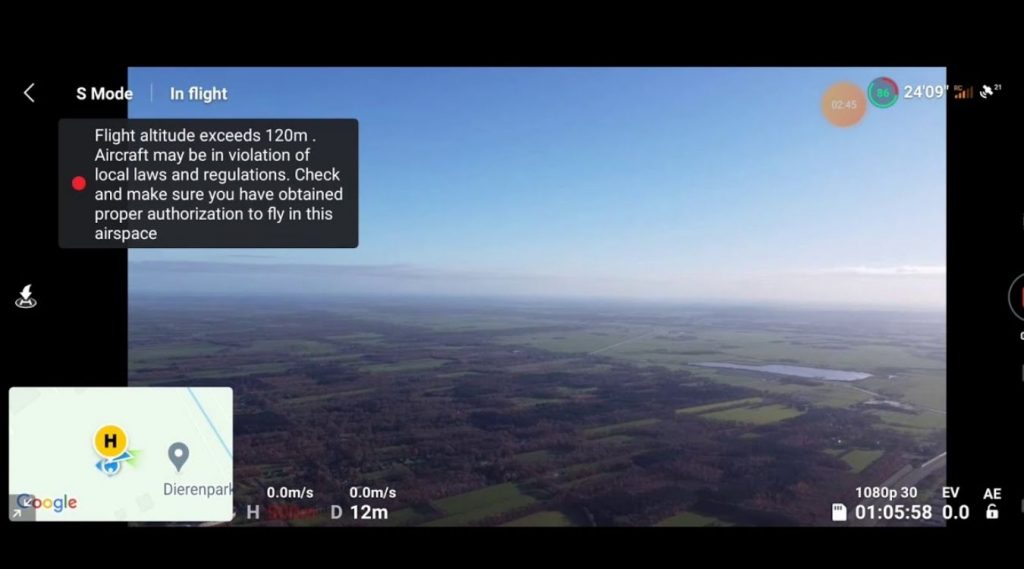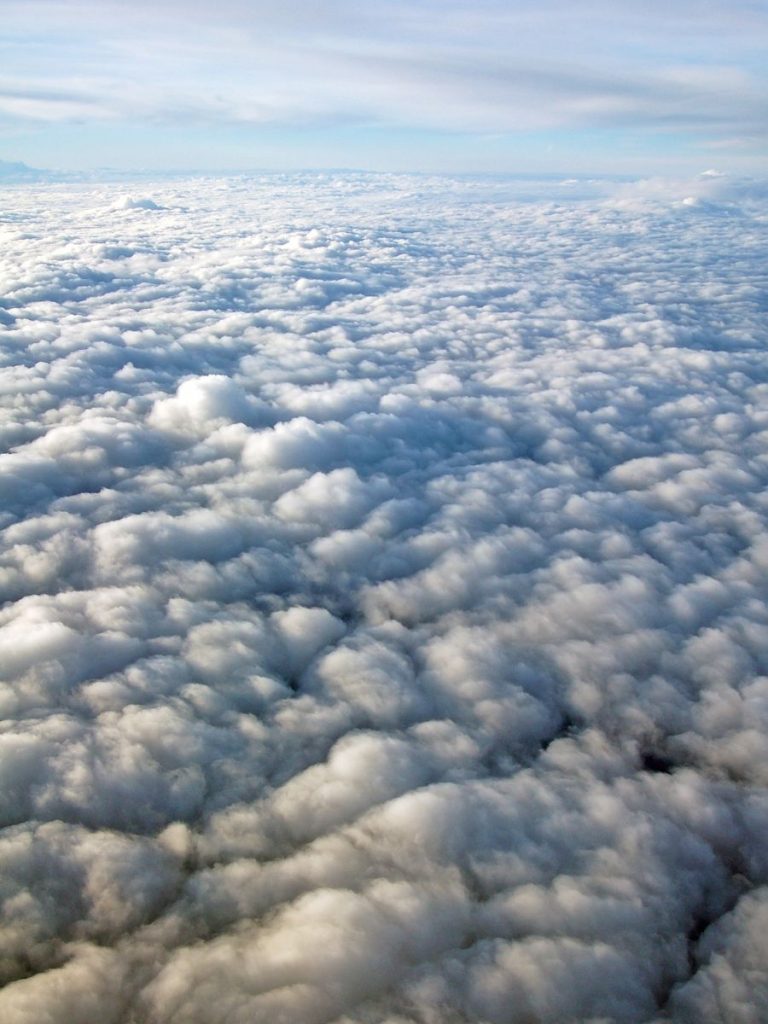The DJI Mini 2 is an impressive piece of DJI’s superior engineering and manufacturing. It crams so many specs in such a small size that it’s almost unbelievable.
“How high can it go” is always an interesting question when it comes to consumer drones. In today’s article, we are going to discuss DJI Mini 2 max altitude.
So, how high can it really go?
The DJI Mini 2 can take off from an altitude of 4,000 m (14763 ft) and go as high as 500 m (1640 ft) limit set in the firmware. So, the max altitude limit of Mini 2 is 4,500 m (14763 ft).
But you would rarely be taking off from an altitude of 4,000 ft (sea level).
In normal use, you can fly your Mini 2 as high as 500 m from the ground before it hits the altitude limit.

Let’s explore things in a bit more detail and see how high we can fly the DJI mini 2 while still resisting wind and retaining control.
DJI Mini 2 max altitude limit – explained
Your DJI Mini 2 will be limited to flying up to the max altitude of 120 meters (394 feet) by default.
This is because most countries worldwide, including the US and Canada, limit the maximum permissible height for drones to 400 feet above the ground limit.
I have a detailed blog on how high can drones fly if you want to read further details.
As soon as you reach 394 feet or 120 meters, you will start seeing a warning on your screen about the max altitude limit (see photo below)

But you can change this limit inside the DJI Fly app and can set it to as high as 500 meters.
While doing that, make sure you are not putting any air traffic in danger and are not in violation of your local laws.
Technically speaking, you can go much higher with your DJI Mini 2. Apart from the software blocking your ascend, nothing stops you from gaining further altitude.
Your Mini 2 can generate enough lift to go as high as 4,500 meters or around 14,000 feet.
That’s very high. That’s the altitude where helicopters normally fly. Other newer DJI drones like the Mavic Air 2 also have such high altitude capabilities.
I have seen a few daredevils flying their drones to this altitude and beyond perfectly fine.
The drones are capable. It just compromises the safety of manned flights flying at that altitude.
To stop people from trying to climb to that altitude, DJI has put a software lock in all their drones that restrict them from going above 500 meters.
How to get to max 4,500m altitude?
Now that we know the DJI Mini 2 can fly as high as 4,500 meters from sea level but is limited by software, how can we go around this limitation and test the Mini to its full potential?
There are two ways you can go about this. One is a legal way, and the other is, well, not exactly illegal, but – a hack.
The drone measures its altitude from the point it takes off. That take-off point is marked as zero meters, and the drone will fly to a maximum altitude set in the Fly App.
If you take off from the top of a building that is 60 meters high, you can fly to a maximum of 560 meters (500 + 60).
But what if you take off from 4,000 meters height above sea level?
If you go to any mountain resort, you can easily gain a few thousand meters altitude from sea level. The DJI Mini 2 can take off from a maximum altitude of 4,000 meters.
So, if you find a mountain resort that is 4,000 meters in altitude from sea level, you can take off from there and go as high as 500 meters making your total altitude from sea level an astounding 4,500 meters.
See a video from a user that attempts this at the Loveland Pass in the Rocky Mountains, Colorado.
Another way of doing this is hacking the DJI firmware and removing the altitude limit, but for obvious reasons, I will not tell you how to do this.
If you are feeling adventurous and have some computer knowledge, I am sure you will find a way.
BUT, DON’T DO IT unless you can make absolutely sure you won’t put yourself or anyone else in danger.
Why can’t DJI Mini 2 go above 4,500 meters?
4,500 meters is what the manufacturer says it can go. In practice, you might be able to go above that on a good day.
But what factors technically limit the DJI Mini 2 (or any drone) from going above and beyond?
The very first limitation is air density. As you go high, the air gets thinner and thinner.
That’s why, to generate more lift to keep climbing, the motors have to spin faster and faster, drawing more current from the battery.
At a certain height, the air gets so much thin that no matter how fast your motors and propellers spin, the drone won’t be able to generate enough lift to climb further.
Another reason is the lower temperature at high altitudes. When you go high, the air gets colder (thin air retains less heat hence low temperature).
This cold temperature negatively affects the drone’s batteries as they cannot discharge fully when cold. This limits how much power is available to your drone motors.
Due to these limitations, all propeller-type aircraft (including manned aircraft and helicopters) can go up to a certain altitude. It’s called their service ceiling.
Why altitude limit on DJI Mini 2 software?
At this point, you must be wondering why DJI has put an altitude limit on your DJI Mini 2 if it can go as high as 4,500 meters.
Why not unlock the full potential of the drone and let users fly it to its fullest?
There are a few good reasons for that.
1. Legal limitations
Almost all countries have a certain altitude limit on commercial and hobby drones to ensure they don’t intrude on a manned aircraft flight zone.
You can fly your drone as high as 400 feet in the US, but not higher.
Similar restrictions are in other countries as well. So, to be compliant, DJI has put a software lock on how high you can fly.

You get a warning in the Fly app when you reach 400 ft (120 m). If your software limit is set to 500 m (1640 ft) in DJI Fly App, you can climb further, but the app will keep showing a warning.
If they don’t put this limit and any of their drones get into an accident with a manned aircraft, they might be fighting a long and expensive lawsuit.
2. Safety of manned flights
As discussed, the higher you go, the more you put manned flights at risk of collision.
Manned flights operate above 500 feet by law (apart from the immediate surroundings of an airport).
So if you are flying your drone below 500 ft, it creates a safe space for both.
In the early days of consumer drones, many near-miss incidents were reported with manned aircraft, forcing the FAA and others to put up an altitude limit for drones.
To comply with this safety requirement, DJI and other drone manufacturers lock the max altitude limit via software lock.
3. High winds
Wind velocity increases as you go higher. Drones are very small in body size and can get thrown around.
Although most drones are highly wind-resistant, including your DJI Mini 2 (it offers level 5 wind resistance), it still can take so much.
High wind can destabilize your drone and can risk a crash.
4. Nothing much to see in the clouds
Well, that’s true. As you higher and higher, your view of the world below gets dimmer. You can’t see much after 400 ft apart from the white clouds.

All the good views can be recorded from below 400 feet, so there is no point going above that height (apart from the fact that you can, so you have to)
Most aerial photography enthusiasts remain close to the ground to capture aerial shots and rarely go to the 400 ft limit.
DJI Mini 2 max altitude – Final words
The DJI Mini 2 is quite capable of climbing to great heights, but it is limited by a software lock to fly below 500 m (1640 ft).
This is to ensure it doesn’t collide with any manned aircraft in the area.
To summarise the discussion, here are the main points to remember:
- Practically, the DJI Mini 2 can go as high as 4,500 meters (14,000+ ft)
- Most countries also don’t allow consumer drones to fly above 120 m (400 ft)
- DJI put a software lock to limit the max altitude to 500 m (1640 ft) only to avoid accidents.
- You get a warning in the DJI Fly app when you cross the 120 m (400 ft) limit, and when you reach 500 m (1640 ft), you stop climbing further up.
I hope this article provides a good explanation of the DJI Mini 2 max service ceiling and how high you are actually allowed to fly it by law.
If you have any questions, you can post them in the comments below.
Happy flying.